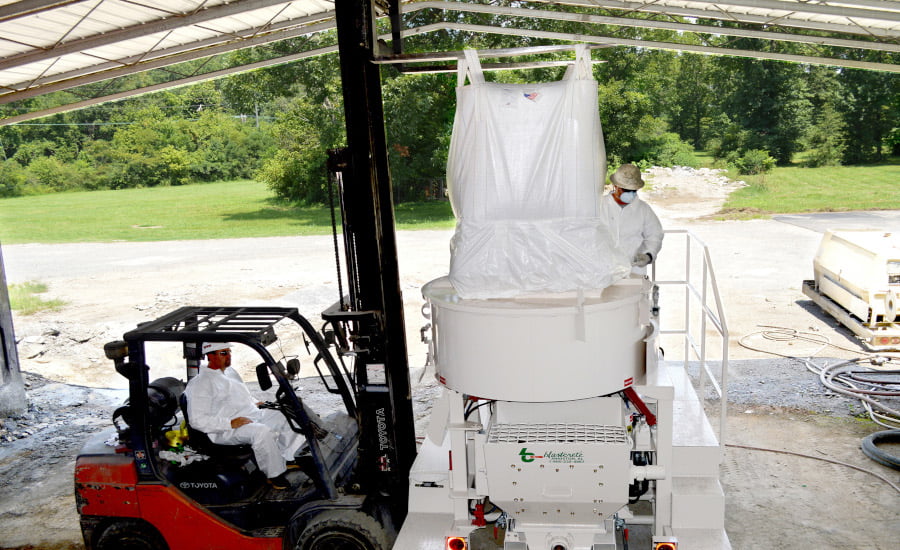Refractory consumption in the production of cement continues to grow worldwide. As contractors look to capitalize on this application, many are looking to monolithic refractory installation as a faster, more efficient process than traditional brick refractory. Thanks to equipment improvements and material innovations — such as no-cement, colloidal silica, which offers optimal alkali resistance and bonding properties —contractors can now install monolithic refractories in areas of cement kilns once reserved for brick refractory. This includes the inlet cone. These improvements and innovations also make it easier and more cost effective for brick refractory contractors to make the switch.
There are three methods used to install monolithic refractory materials: cast-in-place, wet shotcrete, and dry shotcrete. We’ve outlined the pros and cons of each method to help you decide which one might be the best fit for your operation.
Cast-In-Place
The most popular concrete placement process for monolithic refractory installation over large areas is the cast-in-place method, also known as form-and-pour. This process allows you to mix precise amounts of water with material and monitor each batch to ensure a homogenous mixture, maximizing batch quality. Once the material has been mixed properly, it is loaded into a high-pressure swing tube concrete pump and is pumped and vibrated in place.
The major advantages of cast-in-place installation are optimal quality control and a smooth finished surface, minimizing abrasion to the material placed in the kiln. A smooth surface also provides optimal flow in and out of the kiln with little resistance.
Wet Refractory Shotcrete
Using the wet shotcrete process to spray material in place without forms is also popular when lining a large area. It is the preferred method when installation speed is critical to maximizing productivity and profits. You use the same mixing and pumping equipment as cast-in-place but without the forms — hence the name “formless concrete.” The wet refractory shotcrete method also requires the use of materials specifically designed for spraying.
One key difference between the cast-in-place and refractory shotcrete methods is the need to add an accelerator to the material as it’s discharged from the nozzle. This liquid chemical allows the material to begin setting immediately upon impact, speeding up installation time and enhancing quality. Accelerator is pumped to the shotcrete nozzle and controlled by the nozzleman, so this person must have adequate knowledge and experience with chemical accelerators to ensure the material will adhere to a vertical surface properly and not slump.
One of the biggest advantages of the wet shotcrete is that it’s less labor intensive than cast-in-place since no forming is involved. Alternatively, more skill is required on the nozzleman’s part to add the accelerator correctly and properly place the material.
Dry Refractory Shotcrete
The oldest process used to place shotcrete, or formless concrete, is the dry shotcrete method, also known as gunite. The versatility and low cost of rotary gunite machines has helped simplify this method. Rotary guns offer some key advantages, including affordability, portability and ease of maintenance. In addition, it’s easy to adjust material flow through the machine.
In recent years, the introduction of no-cement, colloidal silica refractory materials have made the use of the dry shotcrete process for cement kilns even more versatile. Previously, the gunite method was only used in hard-to-reach areas of the kiln; that’s no longer the case. Thanks to colloidal silica’s alkali resistance and bonding properties, gunite equipment can now be used to install refractory in other areas of cement kilns where smaller, more specialized installations are necessary.
Like the wet process, dry shotcrete also requires a skilled nozzleman since the water is added at the shotcrete nozzle as material passes through a water jacket. However, the liquid addition at the shotcrete nozzle is more forgiving with the use of colloidal silica material, and therefore is less dependent on the nozzleman’s skill.
A Part of Every Process
 All three monolithic refractory installation techniques require the same setup: placing the equipment on the ground and running a steel or rubber delivery line from a concrete pump or gunite machine for material transfer. In many cases, the delivery line can exceed 100 meters in length, with much of it running vertically, making it especially important to choose a powerful, reliable machine.
All three monolithic refractory installation techniques require the same setup: placing the equipment on the ground and running a steel or rubber delivery line from a concrete pump or gunite machine for material transfer. In many cases, the delivery line can exceed 100 meters in length, with much of it running vertically, making it especially important to choose a powerful, reliable machine.
Whichever method you choose, you will need to rely on high-quality and dependable mixing, pumping and spraying equipment for the dense, abrasive refractory materials used in cement kilns. It’s important to ensure that your equipment can handle these conditions with minimal downtime for maintenance or repairs.
Additional features such as swing-out hoppers and easily removable flat packs enable fast and simple maintenance. A combination concrete mixer-pump machine mounted on a single chassis is ideal for maximizing efficiency while minimizing transportation costs, setup time and cleaning.
Although you may be accustomed to installing brick refractory, if you’re open to exploring alternate methods, monolithic refractory installation can offer considerable time and labor cost savings. While the process calls for specific mixing and material placement, advances in equipment designs and materials make it an ideal time to expand your services into monolithic refractory installation.

